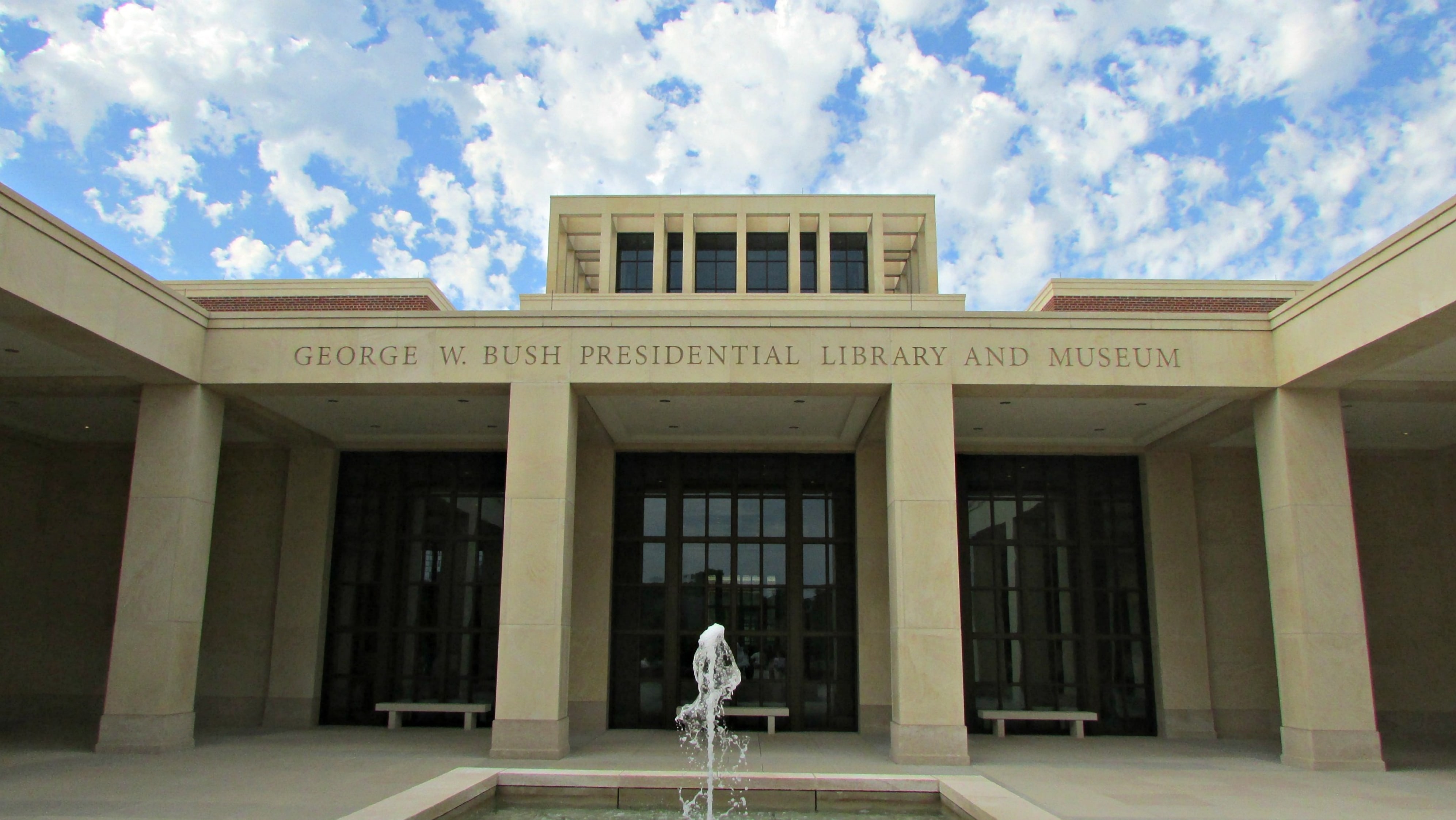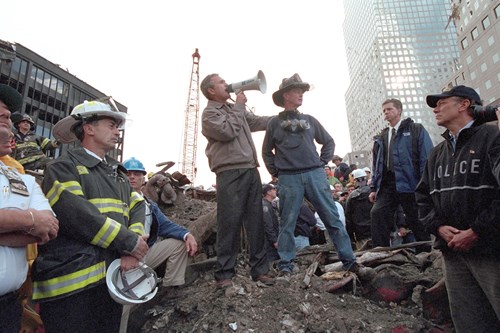Presidential Museums and Libraries: Special Focus on the George W. Bush Presidential Library and Museum

ArtDependence Magazine has collaborated with some of the most renowned Presidential Museums and Libraries in the United States to learn about how they conserve and collect artifacts and objects of historical and scientific importance for research and public presentation.
According to Wikipedia, the definition of a museum is an institution that cares for and conserves a collection of artifacts and other objects of artistic, cultural, historical, or scientific importance. Many museums make these items available for public viewing through exhibitions that may be temporary or permanent. ArtDependence Magazine has collaborated with some of the most renowned Presidential Museums and Libraries in the United States to learn about how they conserve and collect artifacts and objects of historical and scientific importance for research and public presentation. ArtDependence offers an in-depth perspective into the nation’s most intriguing Presidential Museums. Highlighted below is an interview with Bobbi D. Gruner, Public Affairs & Marketing Manager for the George W. Bush Presidential Library and Museum.
ArtDependence Magazine: Why did President Bush choose Dallas as the location for the George W. Bush Presidential Library and Museum?
Bobbi D. Gruner: Dedicated on April 25, 2013, the Bush Center features a 15-acre park complete with native Texas wildflowers, plants, and an amphitheater; the George W. Bush Presidential Library and Museum, the 13th presidential library operated by the National Archives and Records Administration; the George W. Bush Institute, the non-partisan, public-policy arm of the Bush Center; Café 43, a full-service restaurant; and a museum store.
The process of choosing a location for the Bush Center started years before the 2013 dedication. Several Texas institutions submitted proposals; but in the end, President George W. Bush chose Southern Methodist University (SMU). SMU put forth an excellent plan detailing both the location of the facility and ways the various institutions could work together. The Bush family appreciates the high quality of SMU as an institution of learning, as Mrs. Laura Bush serves on the SMU Board and obtained her degree in education there in 1968. The University also has the benefit of being well-situated in Dallas, a major metropolitan area in the heartland of the nation. An academic institution of 11,000 students near downtown Dallas, SMU has proven to be a significant partner.
After the location for the Bush Center was chosen, the private George W. Bush Foundation was responsible for funding, hiring, and overseeing those involved in design and construction. Robert A. M. Stern, dean of the Yale School of Architecture, was hired as the architect. The PRD Group was brought on board as the exhibit design firm. Later, Manhattan Construction was hired to build the facility, and Design and Production Incorporated (D&P) was contracted to oversee fabrications and installation of exhibitions.
Once the structure was complete, the Bush Foundation donated space to the National Archives and Records Administration for the George W. Bush Presidential Library and Museum. The other portion of the building contains the Bush Institute; Café 43, a full-service restaurant; a museum store; and private offices.

9/11 Exhibit. President at Ground Zero
AD: What are the highlights of the museum?
BDG: The George W. Bush Presidential Library and Museum is the 13th Presidential Library operated by the National Archives and Records Administration, a U.S. federal agency.
The primary mission of every Presidential Library is providing information, and at the heart of that mission are the library’s archival collections. The Bush Library has an immense set of materials. First, what differentiates this collection from other presidential libraries is the size of its electronic records archive. The Bush Library has 80 terabytes of electronic information, including 200 million emails. If these emails were printed, they would total more than 1 billion pages.
Second, the textual collection consists of roughly 70 million pages of paper records. This collection includes not only Bush’s presidential records but also his gubernatorial records, which the Bush Library holds in partnership with the Texas State Library and Archives Commission. Third, the audio-visual archives are enormous with about 30,000 audiovisual recordings, 227 cubic feet of photo negatives, and just over 3.8 million photographs. The Bush administration converted to digital photography in 2005, so this presidential library has many more photographs than any of its predecessors.
This immense volume of materials provides a wonderful resource for research, but also poses a challenge for the National Archives and Records Administration. For example, due to the volume of electronic records, when researchers were first permitted to make Freedom of Information Act requests to view George W. Bush presidential records in January 2014, more records were requested within the first week than have been processed at the Ronald Reagan Presidential Library in 25 years.
Additionally, the Bush Library maintains approximately 43,000 artifacts, primarily foreign and domestic gifts given to the President and Mrs. Bush, and other items obtained throughout the presidency at events and during trips. Most famously, perhaps, the Bush Library has the bullhorn used by President Bush during his visit to the World Trade Center after the terrorist attacks of September 11, 2001. These artifacts document the American experience and are used extensively in the Bush Library’s permanent and special exhibits.
The third way the Bush Library provides information is through its permanent and special exhibits. Since opening to the public on May 1, 2013, more than 700,000 people have toured the museum. From the beginning, it was decided the galleries should not be a strictly chronological history of the administration, but instead focus on how the key ideas or principles of freedom, responsibility, opportunity, and compassion were put into practice by the President and Mrs. Bush. Almost every section of the gallery has an interactive component of some type, encouraging visitors to explore and gather more information.
The museum has many highlights, including a section on the President’s domestic policy that suddenly ends as visitors turn a corner and see a 22-foot piece of steel from the World Trade Center, surrounded by videos and names of those killed on September 11, 2001. Another part of the exhibit focuses on the War on Terror and the wars in Afghanistan and Iraq, and features an interactive table that allows guests to see a range of documents, videos, and photographs. A full-scale replica of the Oval Office anchors a section on life in the White House. The Decision Points Theater is another very popular part of the exhibit. In this theater, visitors choose from one of four scenarios: the invasion of Iraq, the “surge” in Iraq, the financial crisis, and Hurricane Katrina. Guests may play the role of president and make decisions based on conflicting advice from a wide range of sources. This exercise allows the Bush Library to present the debates on major events in the Bush Administration and to show how all leaders must make decisions based on the information they have in hand and the principles they hold dear.
The Bush Library mounts at least two special exhibits every year. One is always a holiday exhibit that follows chronologically the holiday themes from the Bush White House. The other is on some topic of relevance to the Bushes, the Bush Administration, the presidency, and/or American history.

Steal Beam w/Monitors
AD: What are the mission and goals of the museum?
BDG: Operated by the National Archives and Records Administration, the Presidential Libraries strive to promote a better understanding of the presidency and the American experience. They preserve and provide access to historical materials, support research, and create interactive programs and exhibits that educate and inspire. Presidential Libraries present vast archives of documents, museums full of important Presidential artifacts, interesting educational and public programs, and informative websites. They are repositories for the papers, records, and historical materials of the Presidents. The staff of Presidential Libraries work to ensure that these irreplaceable items are preserved and made available for the widest possible use by researchers. Presidential Libraries give visitors the chance to see, hear, and participate in the events that changed our lives and made us who we are as a nation.
AD: Which upcoming exhibitions are planned for the museum?
BDG: Deck the Halls and Welcome All: Christmas at the White House 2006, Nov 15, 2018 – Jan 6, 2019

Oval Office, Full-Size Replica
AD: Do the Presidential Libraries work together in lending memorabilia and other capacities?
BDG: The Presidential Library System, operated by the National Archives and Records Administration, is comprised of 14 Presidential Libraries documenting Presidents Herbert Hoover through Barack Obama. Listed in the order in which they were added to the system, Presidential Libraries and their dedication dates include:
- Franklin D. Roosevelt Presidential Library and Museum, July 4, 1940
- Harry S. Truman Presidential Library and Museum, July 6, 1957
- Dwight D. Eisenhower Presidential Library and Museum, November 11, 1954 (Museum) and May 1, 1962 (Library)
- Herbert Hoover Presidential Library and Museum, August 10, 1962
- Lyndon B. Johnson Presidential Library and Museum, May 22, 1971
- John F. Kennedy Presidential Library and Museum, October 20, 1979
- Gerald R. Ford Presidential Library and Museum, April 27, 1981 (Library) and September 18, 1981 (Museum)
- Jimmy Carter Presidential Library and Museum, October 1, 1986
- Ronald Reagan Presidential Library and Museum, November 4, 1991
- George Bush Presidential Library and Museum, November 6, 1997
- William J. Clinton Presidential Library and Museum, November 18, 2004
- Richard Nixon Presidential Library and Museum, July 11, 2007
- George W. Bush Presidential Library and Museum, April 25, 2013
- Barack Obama Presidential Library, TBD
In addition to other partners and local museums, the Presidential Libraries frequently work together to support special exhibits. For example, for the George W. Bush Presidential Library and Museum’s 2016 The Path to the Presidency exhibit, the Ronald Reagan Presidential Library and Museum loaned several Ronald Reagan-George H. W. Bush campaign artifacts; the LBJ Presidential Library loaned a 1968 “Nixon’s the One!” campaign album by Connie Francis; and the William J. Clinton Presidential Library loaned the sunglasses worn by candidate Bill Clinton during his June 3, 1992 appearance on The Arsenio Hall Show.
Presidential Libraries also host special exhibits created by the National Archives and Records Administration. In May 2018, the Museum of Biblical Arts and the Bush Library will present Discovery and Recovery: Preserving Iraqi Jewish Heritage, an amazing exhibit detailing the dramatic recovery of historic materials relating to the Jewish community in Iraq from a flooded basement in Saddam Hussein’s intelligence headquarters, and the National Archives and Records Administration’s ongoing work in support of U.S. government efforts to preserve these materials. Running through September 3, 2018, the Discovery and Recovery exhibit, in both English and Arabic, features 22 recovered original items and a “behind the scenes” video of the fascinating yet painstaking preservation process. This exhibition was created by the National Archives and Records Administration, with generous support from the U.S. Department of State.
Image on top: Building of the George W. Bush Presidential Library and Museum
All images: photo credit The National Archives and Records Administration, and the Bush Center.
